Butterflies and moths have been separated in most languages for a long time indeed. Scientifically however the two groups do not exist. Yet even scientists continue to use the distinction. So we will be happily using it on these pages as well. There are two main differences between butterflies and moths. Moths have a connection between the front wing and the hind wing, which butterflies lack. Butterflies therefor can manipulate the two wings separately. Furthermore all butterflies have rather long, threadlike antennae ending in a knob. Moths have all kinds of antennae, but never threads ending in a knob. Sometimes other differences are mentioned, but usually these do not exist. Most butterflies do fly during daytime, but some fly during the night as well. And some moths fly in broad daylight only, like the clearwings
You are using an out of date browser. It may not display this or other websites correctly.
You should upgrade or use an alternative browser.
You should upgrade or use an alternative browser.
شناسایی Butterflies
- شروع کننده موضوع afsoon6282
- تاریخ شروع
Admirals (Nymphalidae)
Admirals (Nymphalidae)
Admirals (Nymphalidae)
Admirals (Nymphalidae)
Most of the more colourful and larger butterflies in Europe belong to this family. In many cases there is a big difference between the underside and the upperside of the wings. The underside is dark and often cryptically coloured, if coloured at all. This is to make the butterfly hard to spot when it is in hibernation. When landed on flowers the wings are continously opened and closed thus deterring hunters like birds and Dragonflies. Nowadays Satyrs are placed in this family as well, making it one of the biggest butterfly families.
Most of the more colourful and larger butterflies in Europe belong to this family. In many cases there is a big difference between the underside and the upperside of the wings. The underside is dark and often cryptically coloured, if coloured at all. This is to make the butterfly hard to spot when it is in hibernation. When landed on flowers the wings are continously opened and closed thus deterring hunters like birds and Dragonflies. Nowadays Satyrs are placed in this family as well, making it one of the biggest butterfly families.
Painted Lady Vanessa cardui
Painted Lady Vanessa cardui
Painted Lady Vanessa cardui
Painted Lady Vanessa cardui
Every year a Painted Lady visits our garden. In most cases however we see only one species at a time. It's definitely not as common as the Admiral even though, just like the Admiral, it is a migrating butterfly. It usually lives in Northern Africa and from there it conquers the rest of Europe every summer. Occasionally the Painted Lady reaches as far as Iceland. The species is to be found all over the world, except for South-America.
More detailed information about this species in the near future.
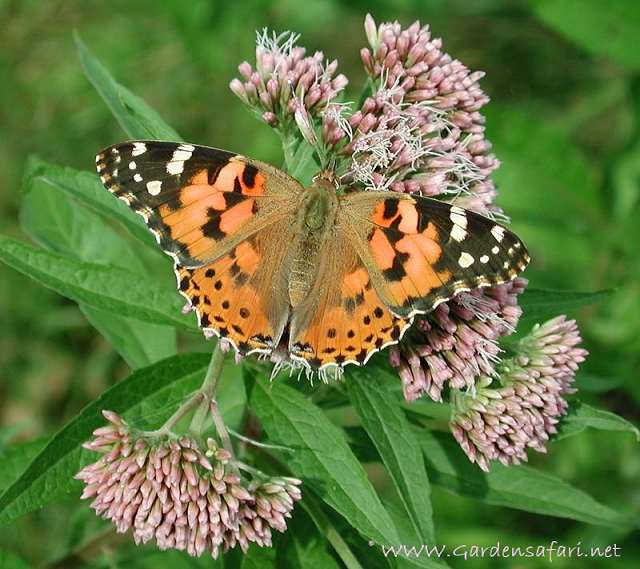
Every year a Painted Lady visits our garden. In most cases however we see only one species at a time. It's definitely not as common as the Admiral even though, just like the Admiral, it is a migrating butterfly. It usually lives in Northern Africa and from there it conquers the rest of Europe every summer. Occasionally the Painted Lady reaches as far as Iceland. The species is to be found all over the world, except for South-America.
More detailed information about this species in the near future.

The Admiral Vanessa atalanta
The Admiral Vanessa atalanta
The Admiral Vanessa atalanta
Admiral Vanessa atalanta
As you might conclude from the scientific name the Painted Lady is a close relative of the already mentioned Admiral. They do look alike a bit, but the Admiral is much darker. Just like the Painted Lady the Admiral lives in Northern Africa and it is able to survive winter in Southern Europe as well. In very mild winters some manage to live through the winter in more northern parts of Europe. In England this frequently happens. Part of the generation born in Central and Northern Europe returns in fall to Southern Europe and Africa.
More detailed information about this species in the near future.

As you might conclude from the scientific name the Painted Lady is a close relative of the already mentioned Admiral. They do look alike a bit, but the Admiral is much darker. Just like the Painted Lady the Admiral lives in Northern Africa and it is able to survive winter in Southern Europe as well. In very mild winters some manage to live through the winter in more northern parts of Europe. In England this frequently happens. Part of the generation born in Central and Northern Europe returns in fall to Southern Europe and Africa.
More detailed information about this species in the near future.

The Peacock Inachis io
The Peacock Inachis io
The Peacock Inachis io
Peacock Inachis io
There are many more well-known butterflies in this family. In Western Europe the Peacock is one of the most beautiful common butterflies. The 'eyes' on the wings have one purpose only: to deter enemies. The eye resembles the tops of tail feathers of a peacock, hence the name. Many species of butterflies and moths have similar 'eyes'.
More detailed information about this species in the near future.
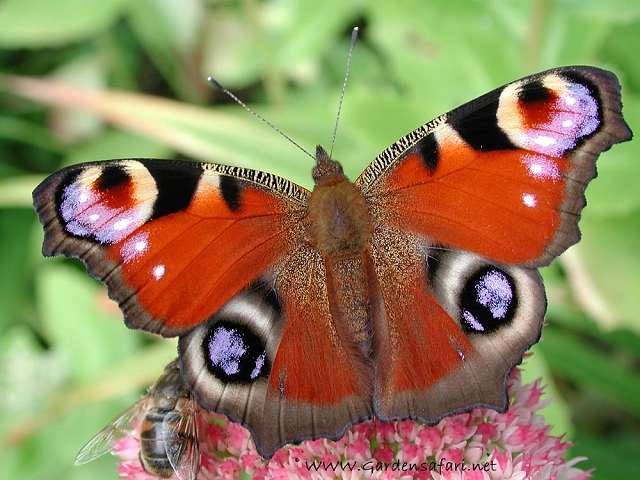
There are many more well-known butterflies in this family. In Western Europe the Peacock is one of the most beautiful common butterflies. The 'eyes' on the wings have one purpose only: to deter enemies. The eye resembles the tops of tail feathers of a peacock, hence the name. Many species of butterflies and moths have similar 'eyes'.
More detailed information about this species in the near future.

Small Tortoiseshell Aglais urticae
Small Tortoiseshell Aglais urticae
Small Tortoiseshell Aglais urticae
Small Tortoiseshell Aglais urticae
Among the most common of butterflies we find the Small Tortoiseshell. This species is sometimes bred by city councils. Once they come out of their cocoon, the butterflies are placed in city parks to make these places appear more lively and natural. The years 2000, 2004 and 2005 were not very good years for Small Tortoiseshells in our garden: only a very few showed up. But it is not unusual for this species to have good and bad years.
More detailed information about this species in the near future.
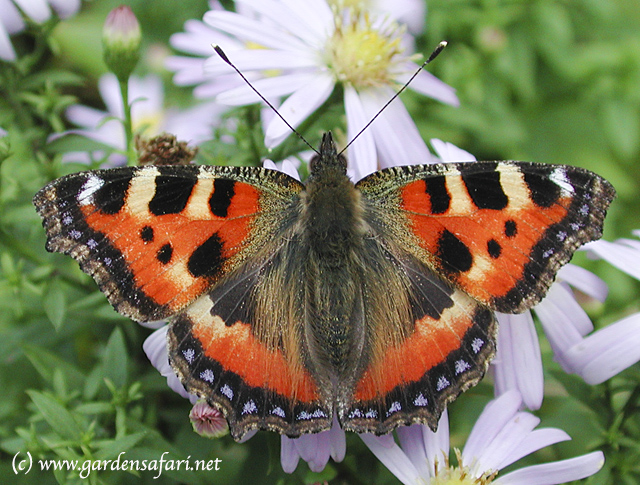
Among the most common of butterflies we find the Small Tortoiseshell. This species is sometimes bred by city councils. Once they come out of their cocoon, the butterflies are placed in city parks to make these places appear more lively and natural. The years 2000, 2004 and 2005 were not very good years for Small Tortoiseshells in our garden: only a very few showed up. But it is not unusual for this species to have good and bad years.
More detailed information about this species in the near future.

The Comma Polygonia c-album
The Comma Polygonia c-album
The Comma Polygonia c-album
Comma Butterfly Polygonia c-album
The Comma or Comma Butterfly is easy to distinguish: its wings are irregularly cut and on the underside of the wings you can clearly see a white 'c' or ','. There are many variations of the butterfly's colour patterns. There are lighter en darker species. To see examples move your mouse over the thumbnails to the left. The lighter species were born in spring and produce a later summer generation. They die in fall. The darker species were born later and do not produce offspring this year, but they go into hibernation in fall and fly around next spring to produce the early generation. Especially in July you sometimes encounter the two generations at the same time.
More detailed information about this species in the near future.
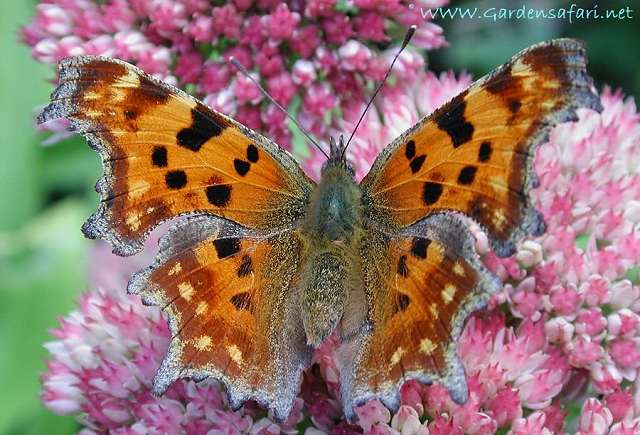
The Comma or Comma Butterfly is easy to distinguish: its wings are irregularly cut and on the underside of the wings you can clearly see a white 'c' or ','. There are many variations of the butterfly's colour patterns. There are lighter en darker species. To see examples move your mouse over the thumbnails to the left. The lighter species were born in spring and produce a later summer generation. They die in fall. The darker species were born later and do not produce offspring this year, but they go into hibernation in fall and fly around next spring to produce the early generation. Especially in July you sometimes encounter the two generations at the same time.
More detailed information about this species in the near future.

The Map Araschnia levana
The Map Araschnia levana
The Map Araschnia levana
The Map Araschnia levana
Measuring approximately 4 centimeters the Map Butterfly is one of the smaller members of this family. It is named after the underside of the wing, which gives the impression of a map. This species has even more variations than the Comma. The first generation resembles somewhat the Small Tortoiseshell. The summer generation, which is depicted below, is almost black. And the generations in between have their own colours and patterns which is a mixture of those of the spring and those of the summer generation. At this moment we do not have any pictures of a representative of the spring generation. :-(
More detailed information about this species in the near future.
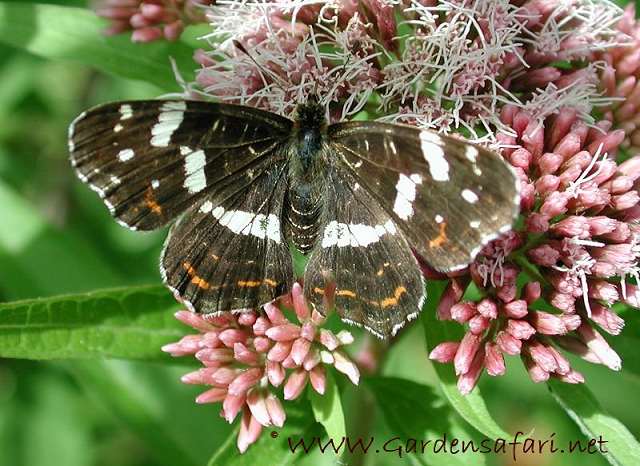
Measuring approximately 4 centimeters the Map Butterfly is one of the smaller members of this family. It is named after the underside of the wing, which gives the impression of a map. This species has even more variations than the Comma. The first generation resembles somewhat the Small Tortoiseshell. The summer generation, which is depicted below, is almost black. And the generations in between have their own colours and patterns which is a mixture of those of the spring and those of the summer generation. At this moment we do not have any pictures of a representative of the spring generation. :-(
More detailed information about this species in the near future.

White Admiral Limenitis camilla
White Admiral Limenitis camilla
White Admiral Limenitis camilla
The White Admiral Limenitis camilla
The inconspicuous species below looks like the map in dark colours, but is larger and is called the White Admiral. We have seen the animal in our garden only once: on July 20th 2001.
More detailed information about this species in the near future.
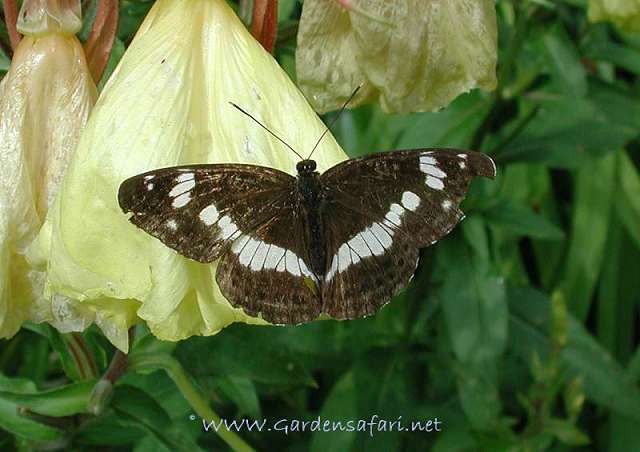
The inconspicuous species below looks like the map in dark colours, but is larger and is called the White Admiral. We have seen the animal in our garden only once: on July 20th 2001.
More detailed information about this species in the near future.

Browns (Satyridae)
Browns (Satyridae)
Browns (Satyridae)
Browns (Satyridae)
The family of Browns is composed of Satyrs and Wood Nymphs. All are brownish butterflies showing eye-shaped spots, usually on both sides of both wings. These eyes either frighten the attacker or mislead them. Predators concentrate on the eyes near the edge of the wing and thus are distracted from the actual body. Besides the 'eyes' on the wings move rapidly, so the attacker gets confused and fails to apprehend the poor victim. Because all species are brown predominantly, they are also referred to as browns. The base of the veines in the wings is swollen in all browns. These parts of the vein are a very rudimentary hearing organ. Some other brush-footed butterflies also have these primitive 'ears', but not all. Nowadays many scientists believe the browns are just a subfamily of the brush-footed butterflies. This subfamily is called Satyrinae. Here we deal with them as being a separate family. In Britain some 11 species exist, in the Benelux countries some 13 species are to be found. Reaching a wingspan of some 35 to 45 mm most browns are quite small. In Southern Europe some bigger species exist, but they have never been found north of the Alps. As most browns are quite dull people tend to overlook them, even though some of the most common butterflies, such as the Wall and the Ringlet belong to this family.
The family of Browns is composed of Satyrs and Wood Nymphs. All are brownish butterflies showing eye-shaped spots, usually on both sides of both wings. These eyes either frighten the attacker or mislead them. Predators concentrate on the eyes near the edge of the wing and thus are distracted from the actual body. Besides the 'eyes' on the wings move rapidly, so the attacker gets confused and fails to apprehend the poor victim. Because all species are brown predominantly, they are also referred to as browns. The base of the veines in the wings is swollen in all browns. These parts of the vein are a very rudimentary hearing organ. Some other brush-footed butterflies also have these primitive 'ears', but not all. Nowadays many scientists believe the browns are just a subfamily of the brush-footed butterflies. This subfamily is called Satyrinae. Here we deal with them as being a separate family. In Britain some 11 species exist, in the Benelux countries some 13 species are to be found. Reaching a wingspan of some 35 to 45 mm most browns are quite small. In Southern Europe some bigger species exist, but they have never been found north of the Alps. As most browns are quite dull people tend to overlook them, even though some of the most common butterflies, such as the Wall and the Ringlet belong to this family.
The Wall Lasiommata megera
The Wall Lasiommata megera
The Wall Lasiommata megera
The Wall Lasiommata megera
A very common Brown is the Wall. Yet we do not see many of them in our garden, probably because it is situated near woods and so attracting Speckled Woods instead of Walls. Separating the males from the females is easy: the males have a broad line of distinctive black scales, which the females lack. These scales produce a scent to which the females are attracted. Most seen are the females. This is due to the males occupying a territory from which other males are chased away, while females may pass freely. Besides the males are extremely unquiet and fly away quickly when disturbed. Photograping the males is a real challenge, while many females are grateful models. In the top picture is a male and in the one below a female.
The Wall is quite common in most of Europe, the Middle East and Central Asia. It is absent though in Northern Scotland, most of Scandinavia and in Ireland. Specimens from southern parts of Europe and from the Middle East are more greyish and less beautiful than specimens from the moderate zones of Europe and Asia. The animal has no particular demands for its presence, except for the grass needed for the caterpillars. It is quite variable in matters of size. Some don't even reach 30 mm, while others reach a wingspan of 46 mm.
The caterpillar of the Wall is bright yellowish green with white stripes. It eats various grasses, like all other caterpillars of browns do. Three broods are produced yearly. The animal is therefore flying about for a long time: from April to November. However the highest numbers of individuals are reached by the end of May and the beginning of June and in August. The caterpillars overwinter. The pupa is attached to grass stems. The Wall is a beautiful brown indeed, sometimes looking like the Small Tortoiseshell because of the colour. The eyes on the backside of the wings give it away immediately though.
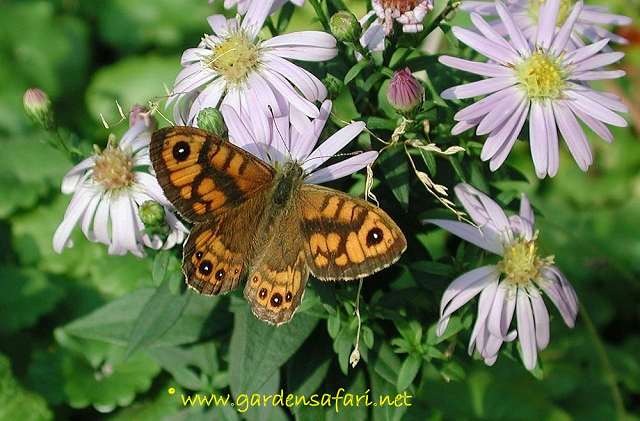
A very common Brown is the Wall. Yet we do not see many of them in our garden, probably because it is situated near woods and so attracting Speckled Woods instead of Walls. Separating the males from the females is easy: the males have a broad line of distinctive black scales, which the females lack. These scales produce a scent to which the females are attracted. Most seen are the females. This is due to the males occupying a territory from which other males are chased away, while females may pass freely. Besides the males are extremely unquiet and fly away quickly when disturbed. Photograping the males is a real challenge, while many females are grateful models. In the top picture is a male and in the one below a female.
The Wall is quite common in most of Europe, the Middle East and Central Asia. It is absent though in Northern Scotland, most of Scandinavia and in Ireland. Specimens from southern parts of Europe and from the Middle East are more greyish and less beautiful than specimens from the moderate zones of Europe and Asia. The animal has no particular demands for its presence, except for the grass needed for the caterpillars. It is quite variable in matters of size. Some don't even reach 30 mm, while others reach a wingspan of 46 mm.
The caterpillar of the Wall is bright yellowish green with white stripes. It eats various grasses, like all other caterpillars of browns do. Three broods are produced yearly. The animal is therefore flying about for a long time: from April to November. However the highest numbers of individuals are reached by the end of May and the beginning of June and in August. The caterpillars overwinter. The pupa is attached to grass stems. The Wall is a beautiful brown indeed, sometimes looking like the Small Tortoiseshell because of the colour. The eyes on the backside of the wings give it away immediately though.

Ringlet Aphantopus hyperantus
Ringlet Aphantopus hyperantus
Ringlet Aphantopus hyperantus
Ringlet Aphantopus hyperantus
The most common brown in our garden is the Ringlet. The butterfly is just as big as the Map, but due to the dark and dull colours it is one of the most unnoticed species. The eye-shaped spots can be seen up close only. Sometimes some eight ringlets visit our garden at the same time. The Ringlet hardly ever rests open-winged. Only after a very cold and wet period they will warm up by opening their wings, othertimes they keep them closed together. The females are not only slightly larger, but they also have three eyes near the top of the inside of the forewing. The male usually does with two eyes only and these may be very faint or even lacking at times.
The Ringlet is a very common species all over the British Isles. It is very common in the rest of Europe as well, except for Italy, Spain and Portugal where it is absent in most areas. The female doesn't lay the eggs on plants: she just flies over grasses and drops her eggs one by one. The caterpillar prefers grasses growing in the shade of bigger plants, especially when these are brambles. The larva is brown and has rather long hairs compared to most caterpillars in this family. Both the caterpillar and the pupa are so well camouflaged that they are rarely ever found in grass, despite the animal being extremely common. This species has only one generation flying from the middle of June to the end of August. Males may reach a wingspan of some 38 mm, females are some 4 mm bigger. Just like the other Satyrs and the Brush-footed Butterflies the front legs are not used for walking or resting. That's why the Ringlet seems to have just four legs.
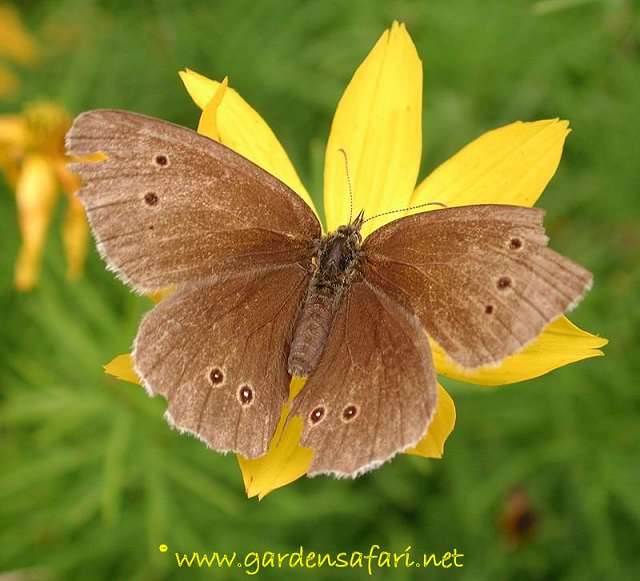
The most common brown in our garden is the Ringlet. The butterfly is just as big as the Map, but due to the dark and dull colours it is one of the most unnoticed species. The eye-shaped spots can be seen up close only. Sometimes some eight ringlets visit our garden at the same time. The Ringlet hardly ever rests open-winged. Only after a very cold and wet period they will warm up by opening their wings, othertimes they keep them closed together. The females are not only slightly larger, but they also have three eyes near the top of the inside of the forewing. The male usually does with two eyes only and these may be very faint or even lacking at times.
The Ringlet is a very common species all over the British Isles. It is very common in the rest of Europe as well, except for Italy, Spain and Portugal where it is absent in most areas. The female doesn't lay the eggs on plants: she just flies over grasses and drops her eggs one by one. The caterpillar prefers grasses growing in the shade of bigger plants, especially when these are brambles. The larva is brown and has rather long hairs compared to most caterpillars in this family. Both the caterpillar and the pupa are so well camouflaged that they are rarely ever found in grass, despite the animal being extremely common. This species has only one generation flying from the middle of June to the end of August. Males may reach a wingspan of some 38 mm, females are some 4 mm bigger. Just like the other Satyrs and the Brush-footed Butterflies the front legs are not used for walking or resting. That's why the Ringlet seems to have just four legs.

Speckled Wood Pararge aegeria
Speckled Wood Pararge aegeria
Speckled Wood Pararge aegeria
Speckled Wood Pararge aegeria
Our garden has sandy soil and is situated very close to forests. Therefore some wood nymphs are also frequent visitors in it. One of them is the Speckled Wood. Even though it has a much livelier design than the Ringlet, it is still a rather dull, brownish butterfly that is often overlooked. It is not very easy to tell males and females apart, except if you know what to look for. Both ***es have eye-shaped spots on the upperside of the hindwings. Males have four of these spots, while females only have three. However all three spots of the females show a white nucleus and look like eyes. In males only two of the spots have a white nucleus, the other two are simply black blobs. The 'eye' that can be seen on the front wing has a bigger white area (actually often consisting of three smaller spots) around them than they do in males. The animal in the top picture is a male and the animal in the picture second from the top is a female.
In and near woodlands the Speckled Wood is a common species in Britain. When it does live near you, you'll have a lot of opportunities meeting it, for it flies for the greater part of the year. In southern parts of Britain it produces three broods flying from March till the end of October. Up north only two broods occur or, even further north, only one, drastically shortening the flying period. On the continent the Speckled Wood is a very common butterfly as well, except for Northern Scandinavia where it is absent. The species however has two colour variations: in Britain, Northern France, the Benelux, Germany, the Balkans and Turkey the light patches in the wing have a creamy colour. This variation is called Pararge aegeria tircis. In the south of France, Spain, Portugal, Italy and Northern Africa the light patches are bright orange, even tending to red going southwards. This subspecies is considered to be the standard and thus is called Pararge aegeria aegeria.
Reaching a wingspan of some 42 mm the Speckled Wood is about the same size as the Ringlet. The caterpillar is green and covered with numerous short white hairs. It, like the Ringlet's caterpillar feeds on various grasses. The species is remarkable, for it may not only overwinter in the larval stage, but as pupa as well, quite unusual in butterflies. This explains the long period it flies about. One frequently sees more than one female flying about. Males are not seen that often, for they occupy a territory. In this territory females are allowed to fly in and out, but other males are chased away immediately. So while the females suck on flowers, the male owner of the territory either keeps watch or is busy chasing away other males!
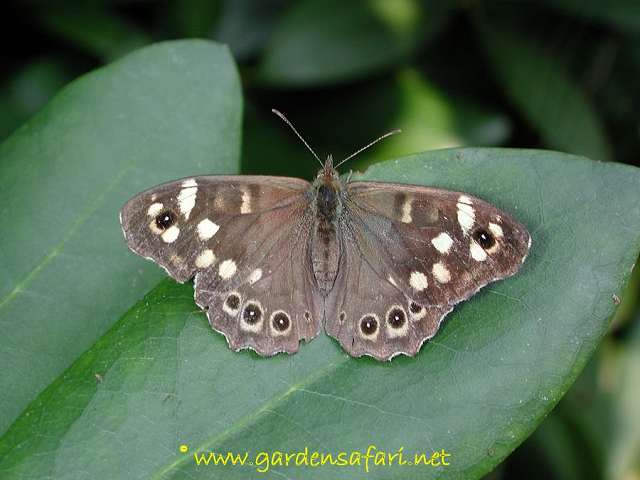
Our garden has sandy soil and is situated very close to forests. Therefore some wood nymphs are also frequent visitors in it. One of them is the Speckled Wood. Even though it has a much livelier design than the Ringlet, it is still a rather dull, brownish butterfly that is often overlooked. It is not very easy to tell males and females apart, except if you know what to look for. Both ***es have eye-shaped spots on the upperside of the hindwings. Males have four of these spots, while females only have three. However all three spots of the females show a white nucleus and look like eyes. In males only two of the spots have a white nucleus, the other two are simply black blobs. The 'eye' that can be seen on the front wing has a bigger white area (actually often consisting of three smaller spots) around them than they do in males. The animal in the top picture is a male and the animal in the picture second from the top is a female.
In and near woodlands the Speckled Wood is a common species in Britain. When it does live near you, you'll have a lot of opportunities meeting it, for it flies for the greater part of the year. In southern parts of Britain it produces three broods flying from March till the end of October. Up north only two broods occur or, even further north, only one, drastically shortening the flying period. On the continent the Speckled Wood is a very common butterfly as well, except for Northern Scandinavia where it is absent. The species however has two colour variations: in Britain, Northern France, the Benelux, Germany, the Balkans and Turkey the light patches in the wing have a creamy colour. This variation is called Pararge aegeria tircis. In the south of France, Spain, Portugal, Italy and Northern Africa the light patches are bright orange, even tending to red going southwards. This subspecies is considered to be the standard and thus is called Pararge aegeria aegeria.
Reaching a wingspan of some 42 mm the Speckled Wood is about the same size as the Ringlet. The caterpillar is green and covered with numerous short white hairs. It, like the Ringlet's caterpillar feeds on various grasses. The species is remarkable, for it may not only overwinter in the larval stage, but as pupa as well, quite unusual in butterflies. This explains the long period it flies about. One frequently sees more than one female flying about. Males are not seen that often, for they occupy a territory. In this territory females are allowed to fly in and out, but other males are chased away immediately. So while the females suck on flowers, the male owner of the territory either keeps watch or is busy chasing away other males!

Meadow Brown Maniola jurtina
Meadow Brown Maniola jurtina
Meadow Brown Maniola jurtina
Meadow Brown Maniola jurtina
The Meadow Brown is another frequent visitor to our garden. This too is a typical woodland species, commonly seen in meadows near woodlands. Just like the Ringlet it is a dark brown species (this applies to the males especially), so it often flies about unnoticed. Often we see three to five specimens in our garden at the same time. The females have a dark orange patch in their wings, the males are almost entirely dark brown. On the backside of the wings the differences are that males have less contrast than the females. That is why the animal in the top picture probably is a male. The animal in the second picture from the top definitely is a female.
The female of the Meadow Brown does look like the Gatekeeper, a related species, which we have not seen in our garden yet. In some books and on some websites the difference between the two species is often indicated to be the eye spot on the front wing. The Gatekeeper always has two white spots in the black blob and the Meadow Brown just one. So when we took our first pictures of the animal shown in the pictures in the fourth picture from above to the left, we were happy to believe it was the Gatekeeper we had been photographing, for the animal shows a beautiful 'double eye'. Unfortunately both Albert de Wilde and Tim Cowles had to correct us: double-eyed Meadow Browns really are a rarity, but they do exist. The difference between the Gatekeeper and the Meadow Brown becomes clear, studying the backside of the wings: the gatekeeper has a few small eyes there, the Meadow Brown doesn't. In Britain the Gatekeeper is common in the south of England only and is absent in Wales, Scotland and Ireland, so no worries of mixing up the species over there.
The Meadow Brown is a common species all over the British Isles. It is on the wing from May to September, even though just one brood is produced. In northern parts of Britain (noticeably Scotland) it flies in June and July only. This species is common on the continent as well and can be found not only in Europe, but in many parts of Central Asia and Northern Africa as well. In the hot southern parts of Europe and Northern Africa it oversummers. Reaching a wingspan of up to 48 mm it is clearly bigger than the previous species. The larva is green and lives on a great variety of grasses. The colour of the pupa is extremely variable: green, yellow, brown, red or even purple.
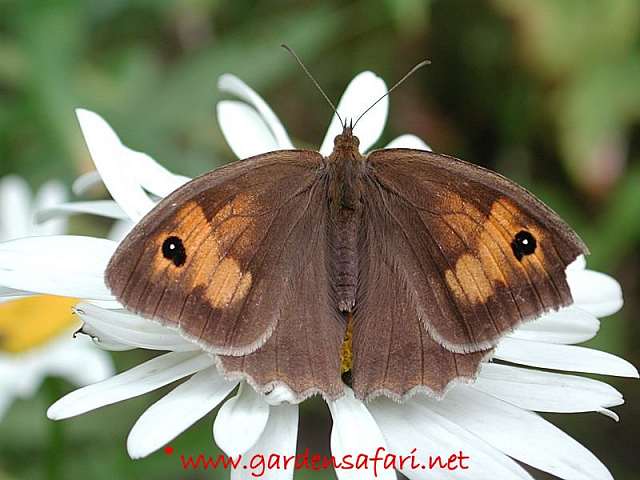
The Meadow Brown is another frequent visitor to our garden. This too is a typical woodland species, commonly seen in meadows near woodlands. Just like the Ringlet it is a dark brown species (this applies to the males especially), so it often flies about unnoticed. Often we see three to five specimens in our garden at the same time. The females have a dark orange patch in their wings, the males are almost entirely dark brown. On the backside of the wings the differences are that males have less contrast than the females. That is why the animal in the top picture probably is a male. The animal in the second picture from the top definitely is a female.
The female of the Meadow Brown does look like the Gatekeeper, a related species, which we have not seen in our garden yet. In some books and on some websites the difference between the two species is often indicated to be the eye spot on the front wing. The Gatekeeper always has two white spots in the black blob and the Meadow Brown just one. So when we took our first pictures of the animal shown in the pictures in the fourth picture from above to the left, we were happy to believe it was the Gatekeeper we had been photographing, for the animal shows a beautiful 'double eye'. Unfortunately both Albert de Wilde and Tim Cowles had to correct us: double-eyed Meadow Browns really are a rarity, but they do exist. The difference between the Gatekeeper and the Meadow Brown becomes clear, studying the backside of the wings: the gatekeeper has a few small eyes there, the Meadow Brown doesn't. In Britain the Gatekeeper is common in the south of England only and is absent in Wales, Scotland and Ireland, so no worries of mixing up the species over there.
The Meadow Brown is a common species all over the British Isles. It is on the wing from May to September, even though just one brood is produced. In northern parts of Britain (noticeably Scotland) it flies in June and July only. This species is common on the continent as well and can be found not only in Europe, but in many parts of Central Asia and Northern Africa as well. In the hot southern parts of Europe and Northern Africa it oversummers. Reaching a wingspan of up to 48 mm it is clearly bigger than the previous species. The larva is green and lives on a great variety of grasses. The colour of the pupa is extremely variable: green, yellow, brown, red or even purple.

Whites (Pieridae)
Whites (Pieridae)
Whites (Pieridae)
Whites (Pieridae)
This family of butterflies is usually called The Whites. Not all members are white, for some are orange or yellow. The family is very common in the moderate temperature zones of the world. Unlike many other butterflies the whites tend to having only one or two colours and little markings on the wings, making them look much duller than many other butterflies. Most species have a wingspan of some 50 mm, meaning they are about the average size of the butterflies common in gardens in Western Europe. The caterpillars usually are greenish and are hairless or have short hairs only. The pupae are attached by self woven belts to plants, trees or even walls. Some species overwinter as caterpillars, most as pupae. In many species females and males are marked differently and can be told apart easily. The adults of the various generations also differ and can be told apart. The differences can be seen only studying resting or feeding animals. When flying about most whites look identical. The caterpillars of some species live on cabbage. Man took cabbage all over the world, often taking the whites with him. Some species are found world wide nowadays, especially the Large White and the Small White. In agriculture they often are considered a pest, the Large White being the most notorious of them all.
This family of butterflies is usually called The Whites. Not all members are white, for some are orange or yellow. The family is very common in the moderate temperature zones of the world. Unlike many other butterflies the whites tend to having only one or two colours and little markings on the wings, making them look much duller than many other butterflies. Most species have a wingspan of some 50 mm, meaning they are about the average size of the butterflies common in gardens in Western Europe. The caterpillars usually are greenish and are hairless or have short hairs only. The pupae are attached by self woven belts to plants, trees or even walls. Some species overwinter as caterpillars, most as pupae. In many species females and males are marked differently and can be told apart easily. The adults of the various generations also differ and can be told apart. The differences can be seen only studying resting or feeding animals. When flying about most whites look identical. The caterpillars of some species live on cabbage. Man took cabbage all over the world, often taking the whites with him. Some species are found world wide nowadays, especially the Large White and the Small White. In agriculture they often are considered a pest, the Large White being the most notorious of them all.
Green-veined White Pieris napi
Green-veined White Pieris napi
Green-veined White Pieris napi
Green-veined White Pieris napi
The Green-veined White is also known as the Mustard White. It can be found in all moderate climat zones of the northern hemisphere, including Japan and Northern America. Except for Northern America this is a very common species. It is a rather small species, having a wingspan of 35 to 45 mm. The species looks like some other whites, particularly the Small White. Still it is easily identified by looking at the underside of the wings: the veins are clearly marked greenish or blackish. The spring generation especially has strongly emphasized veins, like the animal in the top picture. Later generations are bleakly marked at times, like in the 2nd picture from the top.
The Green-veined White is not considered a serious pest, for it seldom eats cabbage. Caterpillars are found on cresses and mustard mainly. Adults are atrrackted by all flowering plants and are often plentiful in our gardens. The first generation is frequently seen on dandelions, later generations often visit thistles. In ordinary gardens this is the smallest of all whites and often the most common. On top males of this species are white, showing but one black dot. In the first generation however this dot is often absent, like shown in the top picture. In later generations the dot may be absent as well or very bleached.
The Mustard White is a very variable species. In females, bottom picture, markings may be absent, like in the males, but females showing more black than white also exist. Scientists still fight over the question whether the one species actually consists of various closely related species or whether all variations are just natural and local appearances of the one species. In all cases though, females are richly marked: the tip of the wing is mostly dark and there are two spots or dots visible. The lower dot is sometimes connected to a black smear near the lower edge of the wing. The markings in the first generation may look rather grey, while the summergenerations are usually with very dark markings. The Green-veined White female does look like the Large White a lot, but is always much smaller.
The Green-veined White is a very common species, flying in two or three generations from March to October. In the subtropical regions it may appear in March, but in the temperate zones the first usually appear by the middle or the end of April. It is abundant in May, July and August. Like many other butterflies it usually feeds and rests holding the wings together in an upright position. In some cases the ***es can still be told apart having their wings upright, as the black spot on the males wing is not or hardly visible on the wings back side, while the dot of the female is very striking, even on the back side. You have to be careful not to be mistaken, for the specimen in the last but one picture does look like a richly marked Small White!
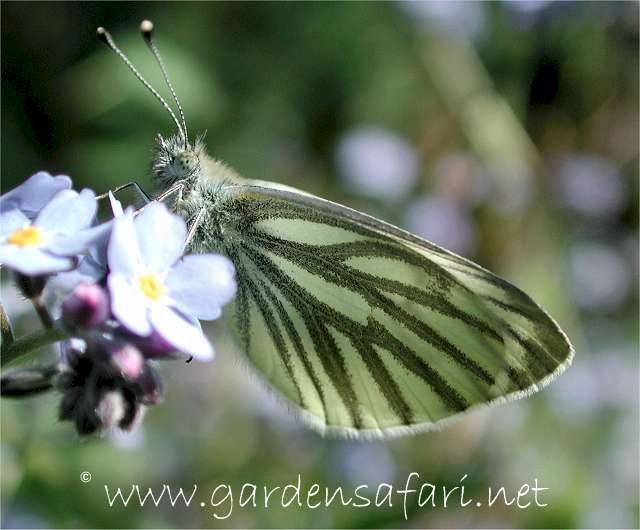
The Green-veined White is also known as the Mustard White. It can be found in all moderate climat zones of the northern hemisphere, including Japan and Northern America. Except for Northern America this is a very common species. It is a rather small species, having a wingspan of 35 to 45 mm. The species looks like some other whites, particularly the Small White. Still it is easily identified by looking at the underside of the wings: the veins are clearly marked greenish or blackish. The spring generation especially has strongly emphasized veins, like the animal in the top picture. Later generations are bleakly marked at times, like in the 2nd picture from the top.
The Green-veined White is not considered a serious pest, for it seldom eats cabbage. Caterpillars are found on cresses and mustard mainly. Adults are atrrackted by all flowering plants and are often plentiful in our gardens. The first generation is frequently seen on dandelions, later generations often visit thistles. In ordinary gardens this is the smallest of all whites and often the most common. On top males of this species are white, showing but one black dot. In the first generation however this dot is often absent, like shown in the top picture. In later generations the dot may be absent as well or very bleached.
The Mustard White is a very variable species. In females, bottom picture, markings may be absent, like in the males, but females showing more black than white also exist. Scientists still fight over the question whether the one species actually consists of various closely related species or whether all variations are just natural and local appearances of the one species. In all cases though, females are richly marked: the tip of the wing is mostly dark and there are two spots or dots visible. The lower dot is sometimes connected to a black smear near the lower edge of the wing. The markings in the first generation may look rather grey, while the summergenerations are usually with very dark markings. The Green-veined White female does look like the Large White a lot, but is always much smaller.
The Green-veined White is a very common species, flying in two or three generations from March to October. In the subtropical regions it may appear in March, but in the temperate zones the first usually appear by the middle or the end of April. It is abundant in May, July and August. Like many other butterflies it usually feeds and rests holding the wings together in an upright position. In some cases the ***es can still be told apart having their wings upright, as the black spot on the males wing is not or hardly visible on the wings back side, while the dot of the female is very striking, even on the back side. You have to be careful not to be mistaken, for the specimen in the last but one picture does look like a richly marked Small White!

Small White Pieris rapae
Small White Pieris rapae
Small White Pieris rapae
Small White Pieris rapae
The Small White is distributed virtually all over the world and reached Australia in 1929, after having been imported in Northern America (first seen Canada in the 1860's, reaching Hawaii in 1898). The species is often referred to as Cabbage White, a name sometimes used for both species the Small White and the Large White. In Australia though only the Small White is meant, as it is the only Cabbage White down under. In Japan the species is called the European Cabbage White. In Northern America however this species is called the Imported Cabbageworm or the Cabbage Butterfly. The Small White is about the size of the Green-veined White, reaching a wingspan of some 45 to 50 mm. It looks like the Green-veined White a lot, but the veins on the backside of the wings are not emphasized by markings. The frontside is identical to that of the Green-veined White: both ***es have the tip of the wings darkened, the males carry one dark dot, the females two. The backside of the wing is quite variable: from a bleached yellowish white to a heavily spotted yellow. These spots however are never concentrated around the veins like in the Green-veined White.
Even though members of the 2nd and 3rd brood usually are a little darker than those of the first generation of the year, these differences are hard to notice and are not as apparent as in the Green-veined White. The Small White is considered to be a real pest in agriculture. Especially in cabbage, mustard, raddish and cress it can do a lot of damage. People have been trying to eliminate the species for centuries, but haven't been very succesful. In modern days poison is still used all over the world, but in protected environments particularly biological methods are used as well. Especially an European parasitc wasp (Apanteles sp.) seems to be quite useful. Other natural enemies include beetles, such as a few Ladybirds, Daddy Long Legs, such as Phalangium opilio, a Plant Bug, certain parasitic flies and a virus. Still, The Small White is very common everywhere and one of the most frequent visitors to gardens, whether in Melbourne, Amsterdam or San Francisco.
In the moderate zones of the world, the Small White will produce some 3 to 4 broods. In subtropical areas it will produce some 8 broods with no pauze whatsoever. When conditions are good, the butterfly will emerge from her pupae after just two weeks! The caterpillars are green, covered with short hairs and do look like the caterpillars of many of the other whites. It is the pupa overwintering, often found on gardenfences, walls etc. Perhaps this is the pupa seen most often by people. Just like some other whites, the Small White is adapted living in moderate climate zones. Thus it is rarely seen sunbathing. Taking pictures of an animal showing the upperside of the wings is a very difficult task. The beautiful blue eyes however are easy to photograph, as the animal is not shy towards people.
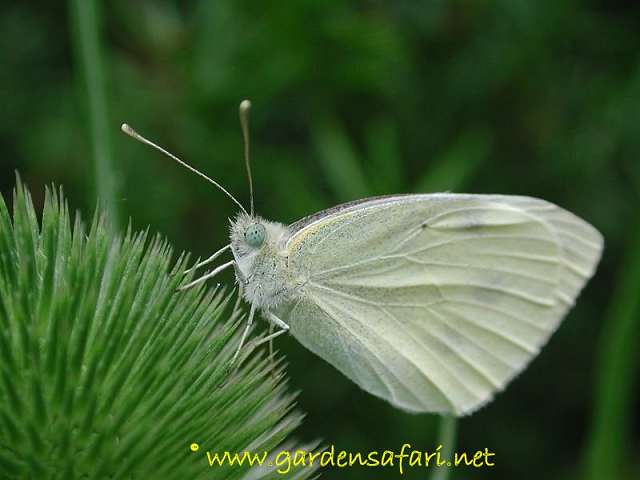
The Small White is distributed virtually all over the world and reached Australia in 1929, after having been imported in Northern America (first seen Canada in the 1860's, reaching Hawaii in 1898). The species is often referred to as Cabbage White, a name sometimes used for both species the Small White and the Large White. In Australia though only the Small White is meant, as it is the only Cabbage White down under. In Japan the species is called the European Cabbage White. In Northern America however this species is called the Imported Cabbageworm or the Cabbage Butterfly. The Small White is about the size of the Green-veined White, reaching a wingspan of some 45 to 50 mm. It looks like the Green-veined White a lot, but the veins on the backside of the wings are not emphasized by markings. The frontside is identical to that of the Green-veined White: both ***es have the tip of the wings darkened, the males carry one dark dot, the females two. The backside of the wing is quite variable: from a bleached yellowish white to a heavily spotted yellow. These spots however are never concentrated around the veins like in the Green-veined White.
Even though members of the 2nd and 3rd brood usually are a little darker than those of the first generation of the year, these differences are hard to notice and are not as apparent as in the Green-veined White. The Small White is considered to be a real pest in agriculture. Especially in cabbage, mustard, raddish and cress it can do a lot of damage. People have been trying to eliminate the species for centuries, but haven't been very succesful. In modern days poison is still used all over the world, but in protected environments particularly biological methods are used as well. Especially an European parasitc wasp (Apanteles sp.) seems to be quite useful. Other natural enemies include beetles, such as a few Ladybirds, Daddy Long Legs, such as Phalangium opilio, a Plant Bug, certain parasitic flies and a virus. Still, The Small White is very common everywhere and one of the most frequent visitors to gardens, whether in Melbourne, Amsterdam or San Francisco.
In the moderate zones of the world, the Small White will produce some 3 to 4 broods. In subtropical areas it will produce some 8 broods with no pauze whatsoever. When conditions are good, the butterfly will emerge from her pupae after just two weeks! The caterpillars are green, covered with short hairs and do look like the caterpillars of many of the other whites. It is the pupa overwintering, often found on gardenfences, walls etc. Perhaps this is the pupa seen most often by people. Just like some other whites, the Small White is adapted living in moderate climate zones. Thus it is rarely seen sunbathing. Taking pictures of an animal showing the upperside of the wings is a very difficult task. The beautiful blue eyes however are easy to photograph, as the animal is not shy towards people.

Large White Pieris brassicae
Large White Pieris brassicae
Large White Pieris brassicae
Large White Pieris brassicae
The Large White looks like the Small White very much. However the black spot in the tip of the wing usually is larger and darker. And it is a larger animal of course. The Small White is about as big as a Small Tortoiseshell. The Large White, having a wingspan of up to 65 mm often is the size of the Admiral or the Peacock, or even a bit larger. It frequently even looks larger than that, for it rarely slides the for and hindwing above oneanother, habitual for both the Mustard White and the Small White. The species can be found in Europe and Northern Asia, but has not been introduced in Northern America and Australia. It was introduced in Chili though turning into a common species. The males differ from the females by being less marked. First generation males have a dark wingtip and two greyish spots. In the second generation these spots are much darker. Females of the first generation also have two spots, but these are very black and clearly visible. In the second generation females the two spots are much larger, often merging into one large black smear.
The Large White is the most damaging among the whites in agriculture. The eggs are deposited in groups, hatch quickly and the caterpillars do have an enormous appetite. Poison is still used frequently to fight the species in agriculture, but the use of certain parasitic wasps also proved successful. The species is very hard to fight though, for in nature the caterpillars will also eat thistles and other big plants. The caterpillars are different from most Whites larvae: they have rather long hairs, are black with dots and yellow lines. They can afford to be rather striking, for they contain a poisonous and badly tasting component extracted from the cabbage plants. This make them poisonous to small birds and foul tasting to bigger ones. The Large White usually has two broods a year, but sometimes a third generation may appear. The pupae of the second generation overwinter. Butterflies are not flying about elegantly, most are just flapping about. But even when the wings are heavily damaged, they manage to fly about in their curious way. The animal in the bottom picture is good proof of that.
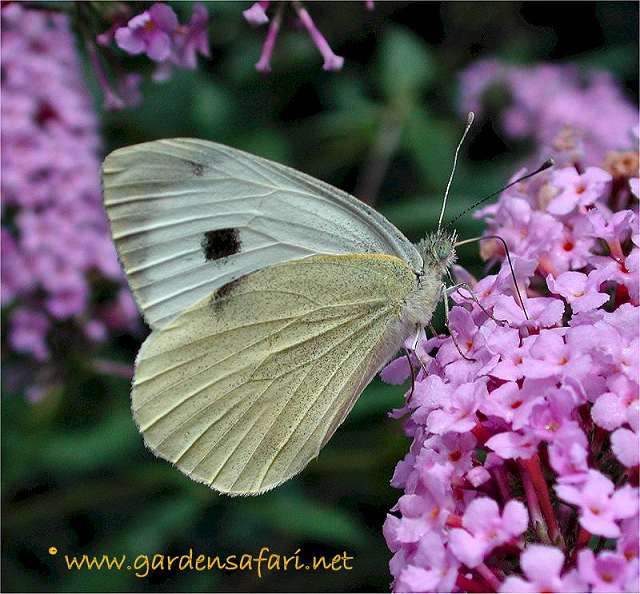
The Large White looks like the Small White very much. However the black spot in the tip of the wing usually is larger and darker. And it is a larger animal of course. The Small White is about as big as a Small Tortoiseshell. The Large White, having a wingspan of up to 65 mm often is the size of the Admiral or the Peacock, or even a bit larger. It frequently even looks larger than that, for it rarely slides the for and hindwing above oneanother, habitual for both the Mustard White and the Small White. The species can be found in Europe and Northern Asia, but has not been introduced in Northern America and Australia. It was introduced in Chili though turning into a common species. The males differ from the females by being less marked. First generation males have a dark wingtip and two greyish spots. In the second generation these spots are much darker. Females of the first generation also have two spots, but these are very black and clearly visible. In the second generation females the two spots are much larger, often merging into one large black smear.
The Large White is the most damaging among the whites in agriculture. The eggs are deposited in groups, hatch quickly and the caterpillars do have an enormous appetite. Poison is still used frequently to fight the species in agriculture, but the use of certain parasitic wasps also proved successful. The species is very hard to fight though, for in nature the caterpillars will also eat thistles and other big plants. The caterpillars are different from most Whites larvae: they have rather long hairs, are black with dots and yellow lines. They can afford to be rather striking, for they contain a poisonous and badly tasting component extracted from the cabbage plants. This make them poisonous to small birds and foul tasting to bigger ones. The Large White usually has two broods a year, but sometimes a third generation may appear. The pupae of the second generation overwinter. Butterflies are not flying about elegantly, most are just flapping about. But even when the wings are heavily damaged, they manage to fly about in their curious way. The animal in the bottom picture is good proof of that.

Brimstone Gonepteryx rhamni
Brimstone Gonepteryx rhamni
Brimstone Gonepteryx rhamni
Brimstone Gonepteryx rhamni
Another well-known white is the Brimstone. The male is citron like yellow and easily identified. The female is almost white and has to be seen in close up. Otherwise she will probably be mistaken for an ordinary white. But in close up you will notice that where all whites have regularly shaped wings, the Brimstone has irregular wingtips. These tips are characteristic of the Brimstone. Except for the colour, little differences exist to separate the males from the females. The Brimstone not anly has irregular wingtips. It is an unusual white in more respects, for it produces only one brood a year. After hatching in May the caterpillars grow up quickly and pupate in June. Soon the adults appear flying about till July when most of them oversummer. In the temperate zones of Northern and Central summer this oversummering doesn't take particularly long, but in the subtropical and Mediterranean zones the animals may be inactive for two or three months! In late summer and autumn they may be seen again, but by september they all seem te have disappeared. The same Brimstones that oversummered first, are now overwintering. But in February or March, when winterdays are over they appear again, thus being the first butterflies of the year in our parts of Europe.
The Brimstone has the common wingspan of a Central European butterfly of up to 55 mm. It's a harmless white, even in agriculture, for its caterpillars are not interested in cabbage at all. They are usually found on Alder. It's very difficult to locate them, as they spend the day resting on the leaves. Their colour is identical to that of the Alder leaves! In Southern Europe (e.g. on the Canary Islands and Madeira) we find a few relatives of our Brimstone. They are usually called Cleopatras and have an orange yellow colour and the same irregular wingtip as our Brimstones have. The Brimstone is a common species all over the British Isles.
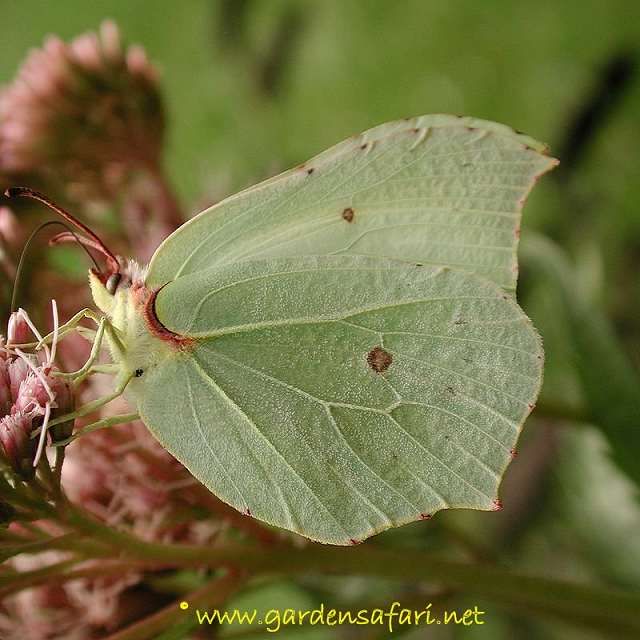
Another well-known white is the Brimstone. The male is citron like yellow and easily identified. The female is almost white and has to be seen in close up. Otherwise she will probably be mistaken for an ordinary white. But in close up you will notice that where all whites have regularly shaped wings, the Brimstone has irregular wingtips. These tips are characteristic of the Brimstone. Except for the colour, little differences exist to separate the males from the females. The Brimstone not anly has irregular wingtips. It is an unusual white in more respects, for it produces only one brood a year. After hatching in May the caterpillars grow up quickly and pupate in June. Soon the adults appear flying about till July when most of them oversummer. In the temperate zones of Northern and Central summer this oversummering doesn't take particularly long, but in the subtropical and Mediterranean zones the animals may be inactive for two or three months! In late summer and autumn they may be seen again, but by september they all seem te have disappeared. The same Brimstones that oversummered first, are now overwintering. But in February or March, when winterdays are over they appear again, thus being the first butterflies of the year in our parts of Europe.
The Brimstone has the common wingspan of a Central European butterfly of up to 55 mm. It's a harmless white, even in agriculture, for its caterpillars are not interested in cabbage at all. They are usually found on Alder. It's very difficult to locate them, as they spend the day resting on the leaves. Their colour is identical to that of the Alder leaves! In Southern Europe (e.g. on the Canary Islands and Madeira) we find a few relatives of our Brimstone. They are usually called Cleopatras and have an orange yellow colour and the same irregular wingtip as our Brimstones have. The Brimstone is a common species all over the British Isles.

Orange Tip Anthocharis cardamines
Orange Tip Anthocharis cardamines
Orange Tip Anthocharis cardamines
Orange Tip Anthocharis cardamines
We had seen the Orange Tip before, but not since we bought our camera and established these pages. Luckily it came back in the spring of 2001. It is not easy to photograph the Orange Tip though, as it restlessly flies about. But of course even the Orange Tip is interested in some flowers and that gave us the opportunity to take some pictures. The one in our garden was not fresh anymore and had a piece of one wing missing, still the pictures are very representative of the species, which hibernates in its pupal stage, being able to appear as an imago at the end of March.
The Orange Tip is about the same size as the Mustard White, reaching a wingspan of 45 mm. It is on the wing from April to the beginning of June. There is just one generation each year. There's only one major difference between the females and the males: the females lack the orange tip. They do look like a common white, except for the marbled backside of the hind wing. This pattern is even visible when looking at the butterfly on top. The greenish caterpillar doesn't differ from most white caterpillars: it's almost hairless and greenish, with a white line running on the sides. In Small White caterpillars the line is yellow and situated more to the back of the animal. The Orange Tip is a common species all over Britain, Northern and Central Europe and Northern Asia, well established in China and Japan as well.
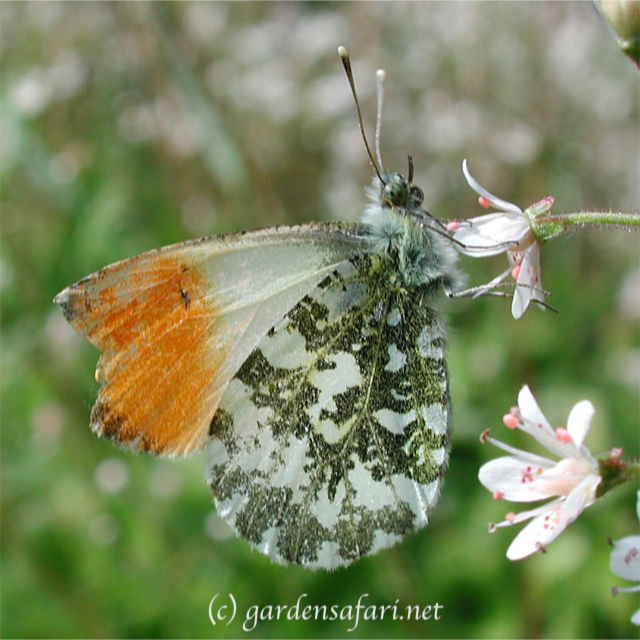
We had seen the Orange Tip before, but not since we bought our camera and established these pages. Luckily it came back in the spring of 2001. It is not easy to photograph the Orange Tip though, as it restlessly flies about. But of course even the Orange Tip is interested in some flowers and that gave us the opportunity to take some pictures. The one in our garden was not fresh anymore and had a piece of one wing missing, still the pictures are very representative of the species, which hibernates in its pupal stage, being able to appear as an imago at the end of March.
The Orange Tip is about the same size as the Mustard White, reaching a wingspan of 45 mm. It is on the wing from April to the beginning of June. There is just one generation each year. There's only one major difference between the females and the males: the females lack the orange tip. They do look like a common white, except for the marbled backside of the hind wing. This pattern is even visible when looking at the butterfly on top. The greenish caterpillar doesn't differ from most white caterpillars: it's almost hairless and greenish, with a white line running on the sides. In Small White caterpillars the line is yellow and situated more to the back of the animal. The Orange Tip is a common species all over Britain, Northern and Central Europe and Northern Asia, well established in China and Japan as well.

Blues and Coppers (Lycaenidae)
Blues and Coppers (Lycaenidae)
Blues and Coppers (Lycaenidae)
Blues and Coppers (Lycaenidae)
The family of the Lycaenidae is generally referred to as Blues. True, a number of species are blue indeed, but they are only a portion of all species within this family. And of many only one side of the wings is blue: the upperside, which many species hardly ever show! Actually this family is comprised of many small sized butterflies that did not fit in any other family. For the coppers are part of this family too. Many coppers look like very small nymphalids, coloured like for instance the Small Tortoiseshell. Another group in this family are the hair streaks, many of which have a small tail like attachment to the wings, making them look like very small Swallowtails (Papilionidae), which are much bigger and whitish or yellowish.
The family of the Lycaenidae is generally referred to as Blues. True, a number of species are blue indeed, but they are only a portion of all species within this family. And of many only one side of the wings is blue: the upperside, which many species hardly ever show! Actually this family is comprised of many small sized butterflies that did not fit in any other family. For the coppers are part of this family too. Many coppers look like very small nymphalids, coloured like for instance the Small Tortoiseshell. Another group in this family are the hair streaks, many of which have a small tail like attachment to the wings, making them look like very small Swallowtails (Papilionidae), which are much bigger and whitish or yellowish.
Holly Blue Celastrina argiolus
Holly Blue Celastrina argiolus
Holly Blue Celastrina argiolus
Holly Blue Celastrina argiolus
The first blue we'd like to introduce to you is the Holly Blue. It is quite numerous in our garden. This is a small species, reaching a wingspan of no more than 30 mm. It is a very common species all over Europe, including the British Isles, except for Scandinavia and the northern parts of Scotland. The caterpillar is keen on Holly and Ivy. The caterpillar excretes a sweet substance, which attract ants. They protect the larva, much the same way they protect aphids. The butterfly appears wherever the foodplants are, even in the centre of big cities, parks, graveyards and gardens. Usually flies in two broods from May to September.
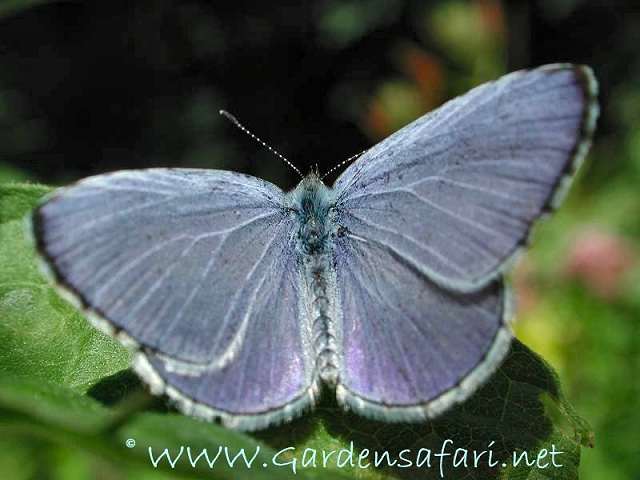
The first blue we'd like to introduce to you is the Holly Blue. It is quite numerous in our garden. This is a small species, reaching a wingspan of no more than 30 mm. It is a very common species all over Europe, including the British Isles, except for Scandinavia and the northern parts of Scotland. The caterpillar is keen on Holly and Ivy. The caterpillar excretes a sweet substance, which attract ants. They protect the larva, much the same way they protect aphids. The butterfly appears wherever the foodplants are, even in the centre of big cities, parks, graveyards and gardens. Usually flies in two broods from May to September.

Common Blue Polyommatus icarus
Common Blue Polyommatus icarus
Common Blue Polyommatus icarus
Common Blue Polyommatus icarus
The first blue we'd like to introduce to you is the Common Blue. It is quite numerous in our garden. This is a small species, reaching a wingspan of no more than 30 mm. It is a very common species all over Europe, including the British Isles, except for Scandinavia and the northern parts of Scotland. The caterpillar is keen on Holly and Ivy. The caterpillar excretes a sweet substance, which attract ants. They protect the larva, much the same way they protect aphids. The butterfly appears wherever the foodplants are, even in the centre of big cities, parks, graveyards and gardens. Usually flies in two broods from May to September.
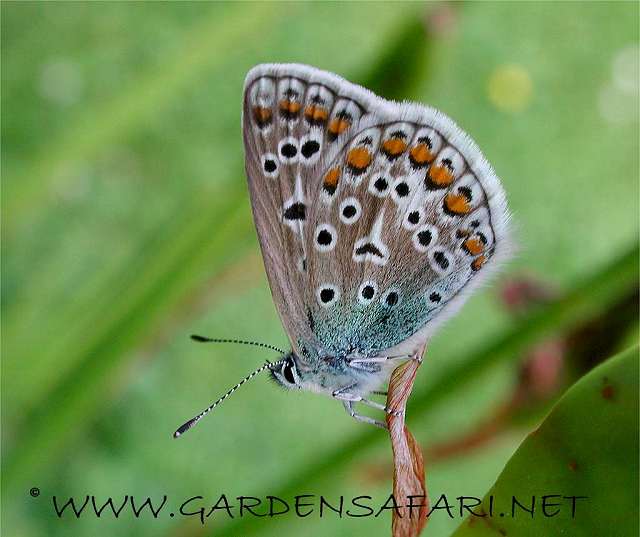
The first blue we'd like to introduce to you is the Common Blue. It is quite numerous in our garden. This is a small species, reaching a wingspan of no more than 30 mm. It is a very common species all over Europe, including the British Isles, except for Scandinavia and the northern parts of Scotland. The caterpillar is keen on Holly and Ivy. The caterpillar excretes a sweet substance, which attract ants. They protect the larva, much the same way they protect aphids. The butterfly appears wherever the foodplants are, even in the centre of big cities, parks, graveyards and gardens. Usually flies in two broods from May to September.

Brown Argus Aricia agestis
Brown Argus Aricia agestis
Brown Argus Aricia agestis
Brown Argus Aricia agestis
So far we have seen the Brown Argus only during a two week-period in the extremely hot summer of 2006. Even though Argus species are blue usually, there is not one single trace of blue in the Brown Argus. The female of the Common Blue is very similar. It isn't very complicated to tell the two species apart. One of the main differences is in the orange spots in the upper wing. In the Brown Argus these are big and visible all over the wing, from edge to edge. In the female Common Blue only the dots at the lower edge of the wing are clearly visible. Going to the upper edge the orange dots get smaller and the last two or three are invisible. This is true for both sides of the upperwing. Another difference is that at the base of the wing there is some blue visible in the Common Blue. There is no blue at all in the Brown Argus. The wingspan is some 2.5cm.
The females of the second generation lay their eggs in August mainly. After hatching the small larvae feed by eating the underside of leaves, leaving the upperside intact (windows). Later they'll eat the entire leaf. The halfgrown caterpillars overwinter between plant debris on the ground. In spring they will complete their cycle. From April onwards the larvae will pupate. They need only some 3 to 4 weeks to give birth to new butterflies. The caterpillars secrete a sweet substance, much loved by ants. The ants in return protect the caterpillar from many small predators. This situation is much like the one between ants and aphids. The larva is green with an indistinct pinkish or purple dorsal line. The foodplants are low growing plants, such as stork's bill and rock rose. The caterpillar will reach a length of some 10 to 13mm only.
The Brown Argus has two generations yearly. The first and smallest is on the wing in May and the first half of June. The second generation is on the wing from July to the end of August. Quite a common species in Southern England, where it may be found on open ground, usually with sandy soils. Also present in most of Wales, but here it is a coastal species only. Not found in Scotland and Ireland. On the continent quite common along the entire European coast and seen regularly along rivers.
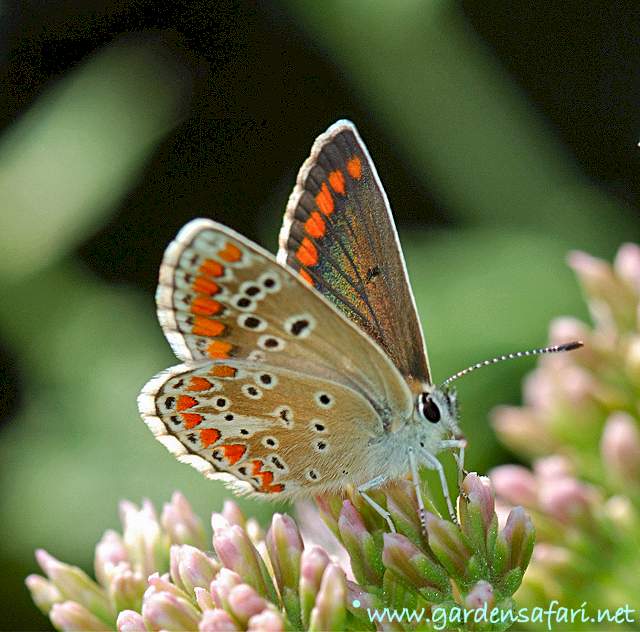
So far we have seen the Brown Argus only during a two week-period in the extremely hot summer of 2006. Even though Argus species are blue usually, there is not one single trace of blue in the Brown Argus. The female of the Common Blue is very similar. It isn't very complicated to tell the two species apart. One of the main differences is in the orange spots in the upper wing. In the Brown Argus these are big and visible all over the wing, from edge to edge. In the female Common Blue only the dots at the lower edge of the wing are clearly visible. Going to the upper edge the orange dots get smaller and the last two or three are invisible. This is true for both sides of the upperwing. Another difference is that at the base of the wing there is some blue visible in the Common Blue. There is no blue at all in the Brown Argus. The wingspan is some 2.5cm.
The females of the second generation lay their eggs in August mainly. After hatching the small larvae feed by eating the underside of leaves, leaving the upperside intact (windows). Later they'll eat the entire leaf. The halfgrown caterpillars overwinter between plant debris on the ground. In spring they will complete their cycle. From April onwards the larvae will pupate. They need only some 3 to 4 weeks to give birth to new butterflies. The caterpillars secrete a sweet substance, much loved by ants. The ants in return protect the caterpillar from many small predators. This situation is much like the one between ants and aphids. The larva is green with an indistinct pinkish or purple dorsal line. The foodplants are low growing plants, such as stork's bill and rock rose. The caterpillar will reach a length of some 10 to 13mm only.
The Brown Argus has two generations yearly. The first and smallest is on the wing in May and the first half of June. The second generation is on the wing from July to the end of August. Quite a common species in Southern England, where it may be found on open ground, usually with sandy soils. Also present in most of Wales, but here it is a coastal species only. Not found in Scotland and Ireland. On the continent quite common along the entire European coast and seen regularly along rivers.

Purple Hairstreak Quercusia quercus
Purple Hairstreak Quercusia quercus
Purple Hairstreak Quercusia quercus
Purple Hairstreak Quercusia quercus
The hair streaks also belongs to the family of blues. These are small butterflies, often greyish or blueish and with a clear tip or hook on the lower wing. There should be lots of Purple Hairstreaks in our garden, but one hardly ever sees them. They usually live up between the tops of Oak Trees and seldom fly near the ground. They favour the sweet excretions from aphids over flowers. Sometimes however a garden with colourful and smelling flowers is irresistable, even for a Purple Hairstreak... The wingspan is some 33 mm at most. Purple Hairstreaks are very common butterflies all over Europe, including most of the British Isles.
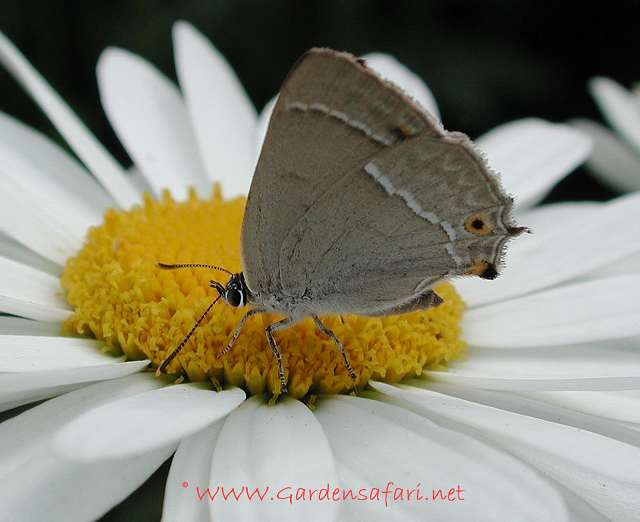
The hair streaks also belongs to the family of blues. These are small butterflies, often greyish or blueish and with a clear tip or hook on the lower wing. There should be lots of Purple Hairstreaks in our garden, but one hardly ever sees them. They usually live up between the tops of Oak Trees and seldom fly near the ground. They favour the sweet excretions from aphids over flowers. Sometimes however a garden with colourful and smelling flowers is irresistable, even for a Purple Hairstreak... The wingspan is some 33 mm at most. Purple Hairstreaks are very common butterflies all over Europe, including most of the British Isles.

Small Copper Lycaena phlaeas
Small Copper Lycaena phlaeas
Small Copper Lycaena phlaeas
Small Copper Lycaena phlaeas
In nature exceptions are more or less the rule. In this case it means that there are blues which are... not blue! In fact there's a whole group of them. Their basic colour is more or less copper and therefore they are actually called: coppers. In most gardens in Holland the Small Copper is a regular guest. It looks very much like a Small Tortoiseshell, only darker and much smaller. The Small Copper can be found in Europe, Northern Africa, Northern Asia and in Northern America and usually is common everywhere. Reaching a wingspan of no more than 25 mm this is a very small butterfly indeed.
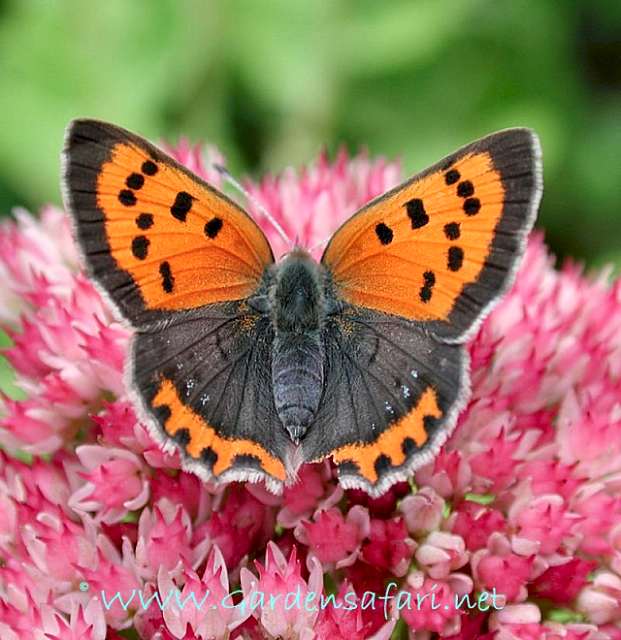
In nature exceptions are more or less the rule. In this case it means that there are blues which are... not blue! In fact there's a whole group of them. Their basic colour is more or less copper and therefore they are actually called: coppers. In most gardens in Holland the Small Copper is a regular guest. It looks very much like a Small Tortoiseshell, only darker and much smaller. The Small Copper can be found in Europe, Northern Africa, Northern Asia and in Northern America and usually is common everywhere. Reaching a wingspan of no more than 25 mm this is a very small butterfly indeed.

Skippers (Hesperiidae)
Skippers (Hesperiidae)
Skippers (Hesperiidae)
Skippers (Hesperiidae)
Skippers all do look like another and when you have seen one, you will always be able to tell whether a butterfly is a skipper or not, even after a very short glimpse. Skippers are heavily built, but have tiny wings. They seem to be a mix between moths and butterflies. They have the heavy body of the owlets or woolly bears, but the antennae have a knob on them, like in any other butterfly. They hold their wings together over the body, something never seen in Owlets and all species fly during day time. So far we had only two species in our garden: the Large Skipper and the Es*** Skipper.
Skippers all do look like another and when you have seen one, you will always be able to tell whether a butterfly is a skipper or not, even after a very short glimpse. Skippers are heavily built, but have tiny wings. They seem to be a mix between moths and butterflies. They have the heavy body of the owlets or woolly bears, but the antennae have a knob on them, like in any other butterfly. They hold their wings together over the body, something never seen in Owlets and all species fly during day time. So far we had only two species in our garden: the Large Skipper and the Es*** Skipper.
Large Skipper Ochlodes venata
Large Skipper Ochlodes venata
Large Skipper Ochlodes venata
It is very easy to mistake skippers for moths. Their large body and very small wings do not remind you much of the grace and colours of, for instance, the Peacock. Nevertheless skippers are real butterflies. The main difference between butterflies and moths is that with moths the two wings are connected. Butterflies lack this connection. Moths are therefore steadier flyers, though not necessarily better flyers. There is another way to tell the two groups apart: the antennae of Butterflies are always rather short, thin like a wire and end in a little knot or dot. The moths have very varying antennae: like a comb, short and thick or long and thin, but never the shape of that of the butterflies. Skippers belong to their own family of butterflies called scientifically Hesperiidae. The Large Skipper may reach a wingspan of some 33 mm, but it looks much smaller because of the tiny wings. The males differ considerably from the females. The wings of the males are rather unmarked, except for a thick black line of scenting scales. The scent dispersed by these scales has one purpose only: to attract females. A male is depicted in the photograph at the top. Just below a female. She has some markings on her wing, but lacks the line of scenting scales. A common species all over Britain.
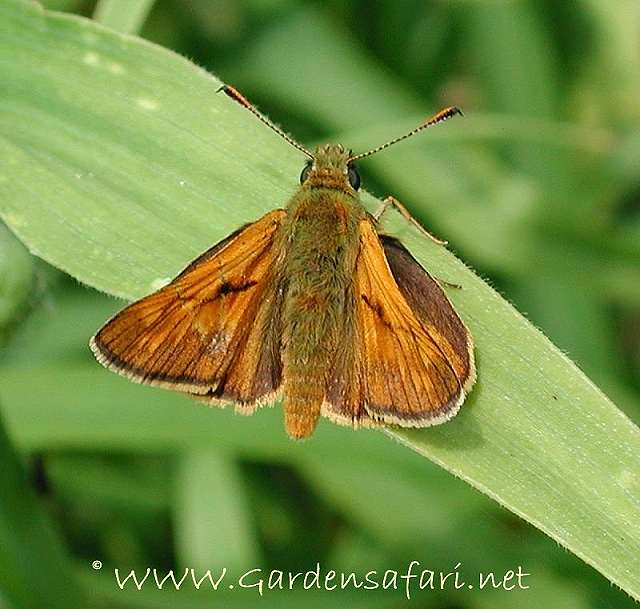

Es*** Skipper Thymelicus lineola
Es*** Skipper Thymelicus lineola
Es*** Skipper Thymelicus lineola
Es*** Skipper Thymelicus lineola
The Es*** Skipper is one of the smallest reddish skippers. It is extremely similar to the Small Skipper, but it is smaller. The two species can be told apart by looking at the ends of the antennae. And I mean the tips of the antennae, not the part just in front of that. In the Small Skipper the tips are yellowish and in the Es*** Skipper the tips are black. Males can be told apart by looking at the scent lines on the wings. The Es*** Skipper has one rather thin line, running parallel to the veins. The Small Skipper has an additional thick line, usually bent, running across the wing. Other similar species, such as the Large Skipper are not only larger, they also have light patches in the wings, lacking in the Es*** Skipper and the Small Skipper. The Es*** Skipper will reach a wingspan of some 22 to 26mm only.
The eggs are round, white and are deposited one by one during the period the animal is on the wing. The embryo soon changes into a caterpillar, but it stays inside the egg. It is not before April of the next year the caterpillar gets out of its egg and starts feeding. Once it does, it develops rapidly indeed: the first adult Es*** Skippers may appear by the middle of June. The larva is green, with a dark green dorsal line. On the sides two lightgreen or whitish lines. It is similar to many other caterpillars, but the markings on the head usually give it away. The head is green. On top are three brown bands and the area between these bands is white. The caterpillars live on and in many species of grass. They are extremely fond of Timothy Grass. They may reach a length of some 24 mm.
Like other skippers, the Es*** Skipper loves to fly. But it does fly clumsely like a butterfly and not like some owlets moths to which it bears a great resemblance. It may be found on a large range of flowers and doesn't seem to be very particular in that respect. It is on the wing from the middle of June to the middle of August. It was taken to the USA accidentally in 1910 and soon became a wide spread pest in grasslands in the North Eastern part of the USA and the eastern part of Canada. In these parts Timothy Grass is grown for hay. Sometimes the Es*** Skipper makes up for 80% of all butterflies present! Actually the animal is present in most parts of Europe, except for Sardinia and the northern parts of Britain and Scandinavia, all over moderate Asia and Japan. In Britain found especially in England and Southern Wales, but it is rapidly expanding its territory and probably is overlooked many times because it is so similar to the Small Skipper.
In the USA this species is better known as the European Skipper.
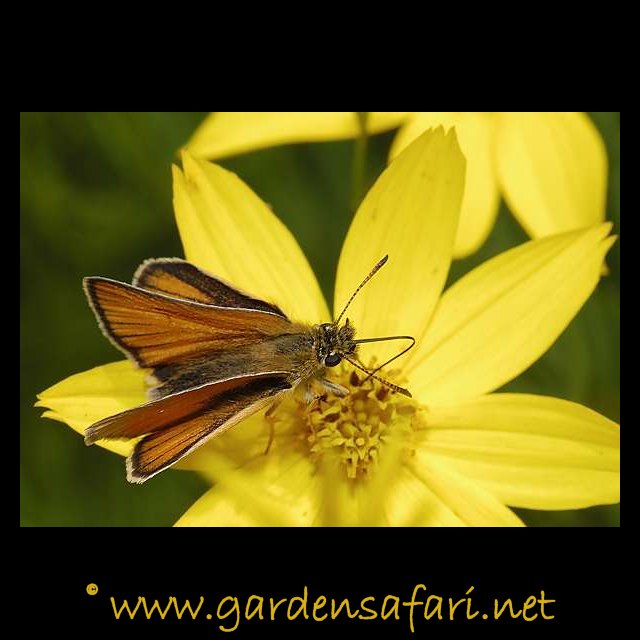
The Es*** Skipper is one of the smallest reddish skippers. It is extremely similar to the Small Skipper, but it is smaller. The two species can be told apart by looking at the ends of the antennae. And I mean the tips of the antennae, not the part just in front of that. In the Small Skipper the tips are yellowish and in the Es*** Skipper the tips are black. Males can be told apart by looking at the scent lines on the wings. The Es*** Skipper has one rather thin line, running parallel to the veins. The Small Skipper has an additional thick line, usually bent, running across the wing. Other similar species, such as the Large Skipper are not only larger, they also have light patches in the wings, lacking in the Es*** Skipper and the Small Skipper. The Es*** Skipper will reach a wingspan of some 22 to 26mm only.
The eggs are round, white and are deposited one by one during the period the animal is on the wing. The embryo soon changes into a caterpillar, but it stays inside the egg. It is not before April of the next year the caterpillar gets out of its egg and starts feeding. Once it does, it develops rapidly indeed: the first adult Es*** Skippers may appear by the middle of June. The larva is green, with a dark green dorsal line. On the sides two lightgreen or whitish lines. It is similar to many other caterpillars, but the markings on the head usually give it away. The head is green. On top are three brown bands and the area between these bands is white. The caterpillars live on and in many species of grass. They are extremely fond of Timothy Grass. They may reach a length of some 24 mm.
Like other skippers, the Es*** Skipper loves to fly. But it does fly clumsely like a butterfly and not like some owlets moths to which it bears a great resemblance. It may be found on a large range of flowers and doesn't seem to be very particular in that respect. It is on the wing from the middle of June to the middle of August. It was taken to the USA accidentally in 1910 and soon became a wide spread pest in grasslands in the North Eastern part of the USA and the eastern part of Canada. In these parts Timothy Grass is grown for hay. Sometimes the Es*** Skipper makes up for 80% of all butterflies present! Actually the animal is present in most parts of Europe, except for Sardinia and the northern parts of Britain and Scandinavia, all over moderate Asia and Japan. In Britain found especially in England and Southern Wales, but it is rapidly expanding its territory and probably is overlooked many times because it is so similar to the Small Skipper.
In the USA this species is better known as the European Skipper.

Similar threads
Similar threads
-
-
شناسایی Centipedes, Millipedes and Woodlice
- شروع شده توسط afsoon6282
- پاسخ ها: 12
-
آشنایی با پرورش و شناسایی کفش دوزک کریپتولموس
- شروع شده توسط roze888
- پاسخ ها: 1
-
-
